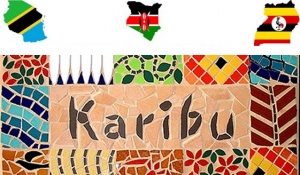Language/Swahili-individual-language/Vocabulary/Count-to-10
Hi Swahili (individual language) learners! 😊
In this lesson, we will be learning how to count to 10 in Swahili (individual language). Knowing numbers is essential not only for daily conversations but also for understanding time, money, and dates with ease.
Introduction[edit | edit source]
Swahili (individual language) is a Bantu language spoken in East Africa, particularly in Tanzania, Kenya, Uganda, and the eastern Democratic Republic of Congo. It is the official language of Kenya and Tanzania and has approximately 140 million speakers worldwide. Understanding basic Swahili (individual language) vocabulary such as numbers is essential when communicating with Swahili (individual language) speakers.
Consider broadening your understanding by checking out these related lessons: Feelings and Emotions, Parts of the Body, Farm & Names and Nationalities.
Numbers 1-10[edit | edit source]
Swahili (individual language) numbers are relatively easy to learn. Let's start with the first ten numbers.
| Swahili (individual language) | Pronunciation | English |
|---|---|---|
| 'moja' | MOH-jah | one |
| 'mbili' | M-bee-lee | two |
| 'tatu' | TAH-too | three |
| 'nne' | n-nay | four |
| 'tano' | TAH-no | five |
| 'sita' | see-TAH | six |
| 'saba' | SAH-bah | seven |
| 'nane' | NAH-neh | eight |
| 'tisa' | TEE-sah | nine |
| 'kumi' | KOO-mee | ten |
Examples in Context[edit | edit source]
Here are some examples of how to use these numbers in context.
- Person 1: 'Je, unayo pesa za kununua chakula chetu?' (Do you have money to buy our food?)
- Person 2: 'Ndio, ninayo elfu tano.' (Yes, I have 5,000.)
- Person 1: 'Ninataka kununua vitabu vinne.' (I want to buy four books.)
- Person 2: 'Mingapi bei yake?' (What is the price?)
- Person 1: 'Bei yake ni shilingi elfu tatu.' (The price is 3,000 shillings.)
Regularities[edit | edit source]
Swahili (individual language) numbers follow a logical pattern. Once you understand the rules, counting beyond ten becomes a breeze. The numbers from eleven to nineteen in Swahili (individual language) are formed by adding 'kumi' (ten) to the corresponding unit, for example:
- kumi moja = eleven
- kumi mbili = twelve
- kumi tatu = thirteen
- kumi nne = fourteen
- kumi tano = fifteen
- kumi sita = sixteen
- kumi saba = seventeen
- kumi nane = eighteen
- kumi tisa = nineteen
Numbers beyond twenty are formed by joining 'ishirini' (twenty) and others, for example:
- ishirini na moja = 21
- ishirini na mbili = 22
- ishirini na tatu = 23
- ishirini na nne = 24
- ishirini na tano = 25
- ishirini na sita = 26
- ishirini na saba = 27
- ishirini na nane = 28
- ishirini na tisa = 29
- the pattern continues for numbers beyond thirty in Swahili (individual language).
Culture and Interesting Facts[edit | edit source]
Swahili (individual language) has a long history dating back to the 10th century when coastal East Africa began to interact with the Arab world, Persia, and India. Over time, the language evolved into a Bantu-Arabic language and became a popular trade language along the East African coast.
Swahili (individual language) is noted for its rhythmic sound and poetic nature. It has contributed significantly to the music and literature of East Africa. Famous Swahili (individual language) songs include 'Jambo Bwana' (Hello Mister) and 'Malaika' (Angel). The latter has been covered by various artists, including African and international musicians such as Miriam Makeba and Harry Belafonte.
Practice Makes Perfect[edit | edit source]
To improve your Swahili (individual language) Vocabulary, you can also use the Polyglot Club website. Find native speakers and ask them any questions! Don't forget to check out the Swahili (individual language) Vocabulary page for more useful words and phrases.
➡ If you have any questions, please ask them in the comments section below.
➡ Feel free to edit this wiki page if you think it can be improved. 😎
Sources[edit | edit source]
Other Lessons[edit | edit source]
- Parts of the Body
- Days of the Week
- Birds
- Family
- Languages Lugha
- Vegetables
- Art
- Geography
- Geometry
- Transportation

